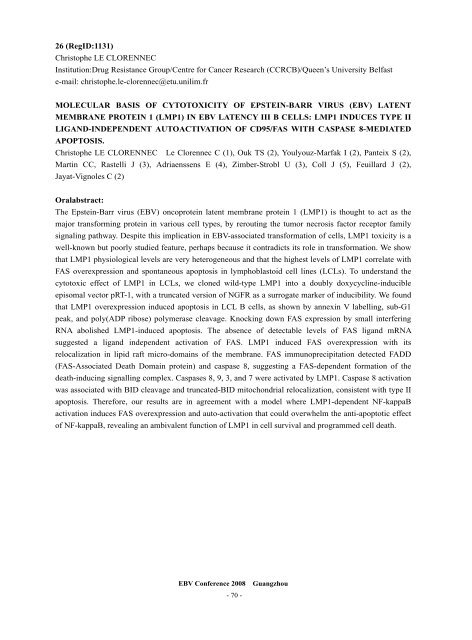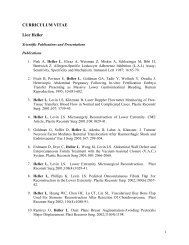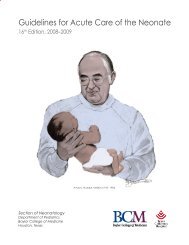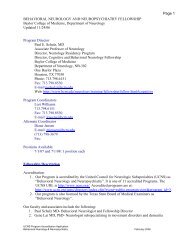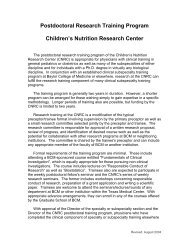EBV Conference 2008 Guangzhou - Baylor College of Medicine
EBV Conference 2008 Guangzhou - Baylor College of Medicine
EBV Conference 2008 Guangzhou - Baylor College of Medicine
Create successful ePaper yourself
Turn your PDF publications into a flip-book with our unique Google optimized e-Paper software.
26 (RegID:1131)<br />
Christophe LE CLORENNEC<br />
Institution:Drug Resistance Group/Centre for Cancer Research (CCRCB)/Queen’s University Belfast<br />
e-mail: christophe.le-clorennec@etu.unilim.fr<br />
MOLECULAR BASIS OF CYTOTOXICITY OF EPSTEIN-BARR VIRUS (<strong>EBV</strong>) LATENT<br />
MEMBRANE PROTEIN 1 (LMP1) IN <strong>EBV</strong> LATENCY III B CELLS: LMP1 INDUCES TYPE II<br />
LIGAND-INDEPENDENT AUTOACTIVATION OF CD95/FAS WITH CASPASE 8-MEDIATED<br />
APOPTOSIS.<br />
Christophe LE CLORENNEC Le Clorennec C (1), Ouk TS (2), Youlyouz-Marfak I (2), Panteix S (2),<br />
Martin CC, Rastelli J (3), Adriaenssens E (4), Zimber-Strobl U (3), Coll J (5), Feuillard J (2),<br />
Jayat-Vignoles C (2)<br />
Oralabstract:<br />
The Epstein-Barr virus (<strong>EBV</strong>) oncoprotein latent membrane protein 1 (LMP1) is thought to act as the<br />
major transforming protein in various cell types, by rerouting the tumor necrosis factor receptor family<br />
signaling pathway. Despite this implication in <strong>EBV</strong>-associated transformation <strong>of</strong> cells, LMP1 toxicity is a<br />
well-known but poorly studied feature, perhaps because it contradicts its role in transformation. We show<br />
that LMP1 physiological levels are very heterogeneous and that the highest levels <strong>of</strong> LMP1 correlate with<br />
FAS overexpression and spontaneous apoptosis in lymphoblastoid cell lines (LCLs). To understand the<br />
cytotoxic effect <strong>of</strong> LMP1 in LCLs, we cloned wild-type LMP1 into a doubly doxycycline-inducible<br />
episomal vector pRT-1, with a truncated version <strong>of</strong> NGFR as a surrogate marker <strong>of</strong> inducibility. We found<br />
that LMP1 overexpression induced apoptosis in LCL B cells, as shown by annexin V labelling, sub-G1<br />
peak, and poly(ADP ribose) polymerase cleavage. Knocking down FAS expression by small interfering<br />
RNA abolished LMP1-induced apoptosis. The absence <strong>of</strong> detectable levels <strong>of</strong> FAS ligand mRNA<br />
suggested a ligand independent activation <strong>of</strong> FAS. LMP1 induced FAS overexpression with its<br />
relocalization in lipid raft micro-domains <strong>of</strong> the membrane. FAS immunoprecipitation detected FADD<br />
(FAS-Associated Death Domain protein) and caspase 8, suggesting a FAS-dependent formation <strong>of</strong> the<br />
death-inducing signalling complex. Caspases 8, 9, 3, and 7 were activated by LMP1. Caspase 8 activation<br />
was associated with BID cleavage and truncated-BID mitochondrial relocalization, consistent with type II<br />
apoptosis. Therefore, our results are in agreement with a model where LMP1-dependent NF-kappaB<br />
activation induces FAS overexpression and auto-activation that could overwhelm the anti-apoptotic effect<br />
<strong>of</strong> NF-kappaB, revealing an ambivalent function <strong>of</strong> LMP1 in cell survival and programmed cell death.<br />
<strong>EBV</strong> <strong>Conference</strong> <strong>2008</strong> <strong>Guangzhou</strong><br />
- 70 -


